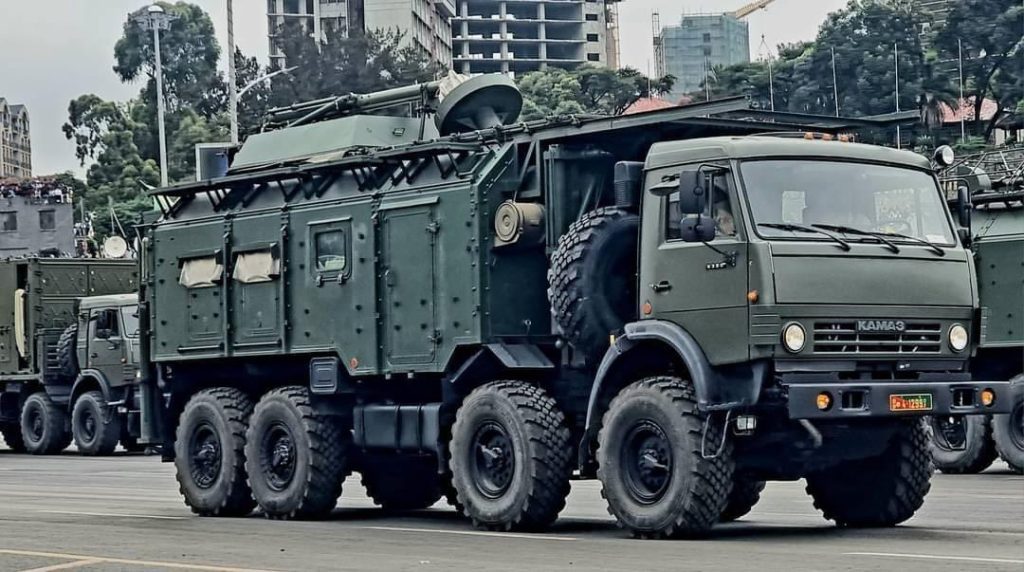Ethiopia marked the 116th anniversary of the establishment of the Ethiopian National Defense Force (ENDF) on October 26, 2023, with a grand celebration. The event, held at Meskel Square in the capital, Addis Ababa, featured a military parade, performances by a march band orchestra, and patriotic songs, attended by Prime Minister Abiy Ahmed, government officials, and military dignitaries.
A standout feature of this year’s army parade was the display of the Russian-made 1RL257 Krasukha-4 electronic warfare system, signifying Ethiopia’s continuous efforts to bolster its military capabilities.
Electronic warfare is a pivotal but invisible part of modern warfare. Military forces rely on radios, radars, and infrared detectors to coordinate operations and find the enemy. They use EW to control the spectrum, protecting their own sensing and communications while denying access to the electromagnetic spectrum by enemy troops.
In 2021, Russia and Ethiopia signed a military cooperation agreement. The military cooperation agreement came after a three days deliberations held as part of the military technical cooperation forum in the Ethiopian capital Addis Ababa. As part of the agreement, Russia supplied a number of equipment to the Ethiopian National Defence Force.
The Krasukha-4 is a formidable electronic warfare system designed to neutralize various threats, including Low-Earth Orbit (LEO) spy satellites, ground-based radars, and airborne radars (AWACS) at ranges ranging from 150 to 300 kilometers. This system also possesses the capability to disrupt the enemy’s Electronic Warfare (EW) systems and communications.
The 1RL257 Krasukha-4 is mounted on a Kamaz 6350 8×8 military truck chassis powered by a KamAZ-740.50-360 diesel engine, capable of producing 360 horsepower. This robust vehicle can reach a maximum speed of 95 km/h and has a road range of up to 1,000 kilometers. Furthermore, its design enables it to ford at depths of up to 1.75 meters.
The Krasukha-4 is structured as a two-part system, composed of an EW system and a command post module, each installed on separate trucks. It is noteworthy that this system has been in operation for over a decade, and it is developed by Concern Radio-Electronic Technologies (KRET), a subsidiary of the Russian state group Rostec, renowned for manufacturing specialized military products.
With an operational range of 186 miles, the Krasukha-4 system is particularly adept at targeting radio-electronic systems, including those on airborne platforms like unmanned aerial vehicles (UAVs) and missile systems. Moreover, the system’s capabilities extend to countering airborne warning and control systems (AWACS), drones, and spy satellites. This multifaceted mobile system is also deployed to disrupt ground-based large radars and shield Russian assets from surveillance systems.
The Krasukha-4 stands as a robust defense system designed to safeguard against a range of threats, and its advanced jamming capabilities are invaluable for safeguarding critical assets. These capabilities make it a substantial addition to Ethiopia’s defense arsenal, particularly amid rising geopolitical tensions concerning the Grand Ethiopian Renaissance Dam (GERD).
The Ukraine invasion shows EW can change the course of a war, but but must operate in tandem with airpower or satellite-guided drones.
In recent times, Ethiopia has made notable acquisitions from countries like China, Israel, and Russia, further enhancing its military capabilities. These acquisitions include state-of-the-art Russian-made Pantsir-S2 air defense systems and Ukrainian ST-68UM radar stations.
Additionally, Ethiopia has procured air defense systems, such as the Israeli Skylock counter-UAS solution, to bolster its preparedness and protect essential projects like the GERD.
The Ethiopian government continues to strengthen its military assets and strategic weapons, including artillery and rocket systems, as well as drones to ensure readiness and resilience in the face of regional challenges and crises.
As Ethiopia marks the 116th anniversary of its National Defense Force, the display of the Krasukha-4 serves as a symbol of the country’s ongoing commitment to safeguard its interests and protect its future endeavors in the face of evolving threats.
